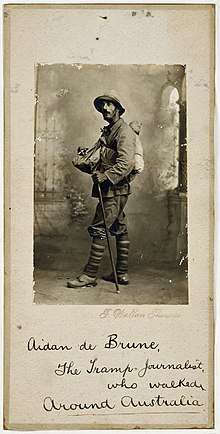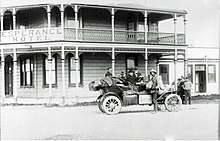Aidan de Brune
Aidan de Brune (17 July 1874 – 15 February 1946), journalist, author, pedestrian was the first person to walk around the perimeter of Australia, unaccompanied and unassisted.[1]
Aidan de Brune | |
|---|---|
 Aidan de Brune before beginning his walk around Australia in 1921 | |
| Born | Herbert Charles Cull 17 July 1874 London, England |
| Died | 15 February 1946 (aged 71) Sydney |
| Other names | Frank de Broune, John Morriss, H. F. C. de B. Culle |
| Known for | Journalist, author |

Walk around Australia
In September 1921 he began a walk around the perimeter of Australia, from Sydney to Sydney, anticlockwise. De Brune described his goal to be "to leave Sydney on foot, to walk ten thousand miles (more or less) around Australia, calling at all the ports en route on the four coasts, and to return to Sydney."[2] He proposed taking twelve months to complete the walk. However, in the event, he took two and a half years, arriving back in Sydney on 4 March 1924.
De Brune kept a diary during his walk, in which he made daily entries detailing the distance walked each day and the total distance to-date. He also invited people he met along the way to certify his presence at the location he was at and to make comments. After he finished his walk he donated the diary[3] and a typescript of the contents of the diary[4] to the State Library of New South Wales.
J T Beckett, a journalist, had met de Brune in Darwin, during de Brune's walk. A newspaper article written by Beckett appeared when de Brune was in Penong, South Australia, about 1700 miles from finishing his walk. Beckett concluded the article: "Aiden de Brune has not finished his walk but should he never move another yard further, he will have put up a record that few, if any, will ever attempt to equal."[5]
Personal life
De Brune was born Herbert Charles Cull in London, England and started his professional life as a printer. He married Ethel Elizabeth Crofts in 1907 and a son, Lionel, was born in 1909.[1]
In 1910 Cull went to Australia, arriving in Fremantle, Western Australia on 23 May 1910. His wife and child followed him and arrived in Albany, Western Australia on 26 November 1910.[1]
In 1912 Cull's wife and son returned to England. Cull remained in Australia for the rest of his life. In early 1920 he was working for the Bunbury Herald newspaper and wrote two serial stories: The Pursuits of Mr Peter Pell and The Mystery of the Nine Stars. The latter story was unfinished when, in November 1920, Cull left the newspaper and began to walk from Fremantle to Sydney, following the Trans-Australian Railway. When he reached Sydney, in early 1921, Cull was calling himself Aidan de Brune.[1]
After his walk around Australia, Aidan de Brune settled in Sydney and began writing serialised mystery stories for newspapers.
Aidan de Brune/Herbert Charles Cull died in Sydney on 15 February 1946. His death was registered as that of Aidan de Brune. He was buried in Botany Cemetery.
References
- The Amateur Tramp: a Walk of Ten Thousand Miles Around Australia by Colin Choat, pp. 15–28. ISBN 978-0-646-98937-2. Retrieved 8 November 2019.
- A Stroll Around Australia, The Moora Herald and Midland Districts Advocate, 8 June 1923. Retrieved 8 November 2018.
- "Aidan Charles Francis De Brune trek round Australia, 20 September 1921 – 1 September 1924." State Library of New South Wales, Call No. B 692.
- "Record diary of a walk around Australia." State Library of New South Wales, Dewey: 980.1/D
- "AIDAN DE BRUNE". Northern Standard (64). Northern Territory, Australia. 5 October 1923. p. 1. Retrieved 11 May 2019 – via National Library of Australia.
External links
- Ebooks by Aidan de Brune at Project Gutenberg Australia, including Record Diary of a Walk Around Australia.